Services running on a firewall cannot be configured to listen to dynamic IP addresses on the box layer of the Barracuda CloudGen Firewall. To use a VPN service on a Barracuda CloudGen Firewall with dynamic WAN connections, configure the firewall to use a localhost IP address (127.0.0.X) and configure the VPN service to listen on the DCHP device. Alternatively, you can configure the VPN service to use the localhost IP address as a listening IP and create an app redirect access rule to redirect all incoming VPN traffic to the local VPN service. For IPsec, you can configure the VPN service to create a listener on every available IP address, making the app redirect access rule unnecessary.
Step 1. Configure VPN Service Listening IP on the Firewall
Verify that services running on the box can use 127.0.0.9 as a listening IP address.
- Go to CONFIGURATION > Configuration Tree > Box > Network.
- Scroll down to the Shared Networks and IPs section and make sure that the IP address is listed under Shared Networks and IPs.

If there is no local address configured, add the shared network.
- Go to CONFIGURATION > Configuration Tree > Box > Network.
- In the Shared Networks and IPs section, click +. The Shared Networks and IPs window opens.
- Enter a name for the new shared network.
- Click OK. The Shared Networks and IPs <your shared network name> window opens.
- For Interface, select Other and enter
lofor the local interface on which the shared network must be reachable. - Enter the Network Address
127.0.0.9/32for the network on the selected interface. - Next to Shared IPs in this Network, click +. The Shared IP Address Configuration window opens.
- In the IP Address field, enter
127.0.0.9 - For Alias for this IP, select First IP.
- Set Responds to Ping to yes.
- Click OK.
- For Trust Level, select Trusted.
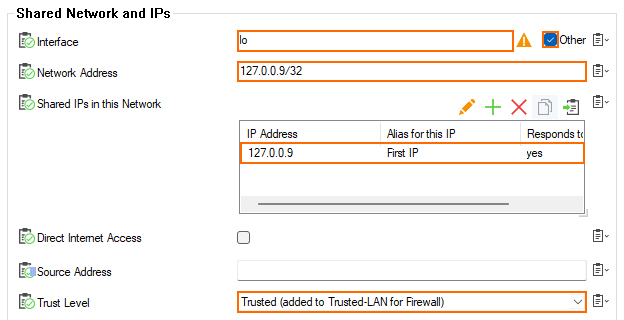
- Click OK. The shared IP address is added to the list of Shared IPs in this Network.
- Click OK.
- Click Send Changes and Activate.
Step 2. Configure the Listener on the VPN Service
Configure the VPN service to listen on the DHCP device.
- Go to CONFIGURATION > Configuration Tree > Box > Assigned Services > VPN-Service > Service Properties.
- Click Lock.
- From the Listening IP drop-down menu, select Device.
- Next to Listening Device, click + and enter
dhcp.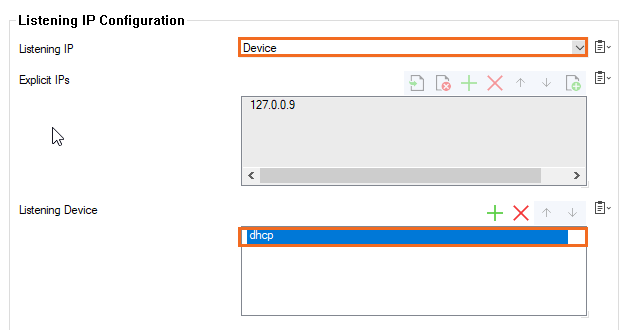
- Click Send Changes and Activate.
Alternatively, you can configure the VPN service to use the 127.0.0.9 listening IP address configured in Step 1 as a service IP address. In this case, you must also create an app redirect rule.
- Go to CONFIGURATION > Configuration Tree > Box > Assigned Services > VPN-Service > Service Properties.
- Click Lock.
- From the Service Availability drop-down, select Explicit.
- Click + and add the IP address
127.0.0.9to the Explicit Service IPs table. - Click Send Changes and Activate.
Step 3. Create a VPN Tunnel
Create a VPN TINA tunnel. On the local firewall, under the Local tab, select Explicit List (ordered) as the IP Address used for Tunnel Address. Select Explicit List (ordered) and enter 0.0.0.0 as the listening IP address.
For more information, see How to Create a TINA VPN Tunnel between CloudGen Firewalls.
Step 4. (optional) Create an App Redirect Access Rule
If the VPN service is configured to use the 127.0.0.9 listening IP address as the service IP address, create an app redirect rule to redirect all incoming VPN traffic on the dynamic WAN interface to the VPN service:
- Action – Select App Redirect.
- Source – Select Internet.
- Service – Select NGF-OP-VPN.
- Destination – Select the network object for your dynamic WAN connection. E.g., xDHCP-LocalIP1 or xDSL-LocalIP1.
- Redirection – Enter
127.0.0.9.
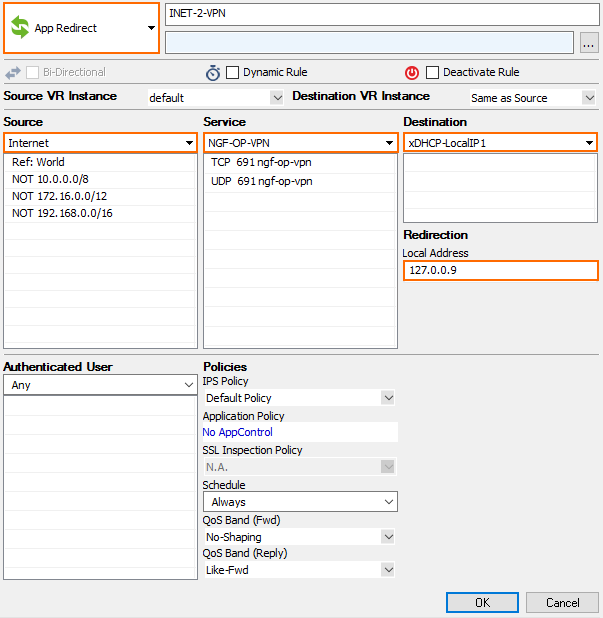
For more information, see How to Create an App Redirect Access Rule.
All incoming VPN traffic is now redirected to the VPN service listening on 127.0.0.9.
IPsec VPN Service Listener on All IP Addresses
When using IPsec, configure the VPN service to listen to all available IP addresses including all dynamic IP addresses. No additional access rules are required.
Configure the VPN Service IP
- Go to CONFIGURATION > Configuration Tree > Box > Assigned Services > VPN-Service > VPN Settings.
- Click Lock.
- In the left navigation bar, click IPSec.
- Enable Use IPSec dynamic IPs.
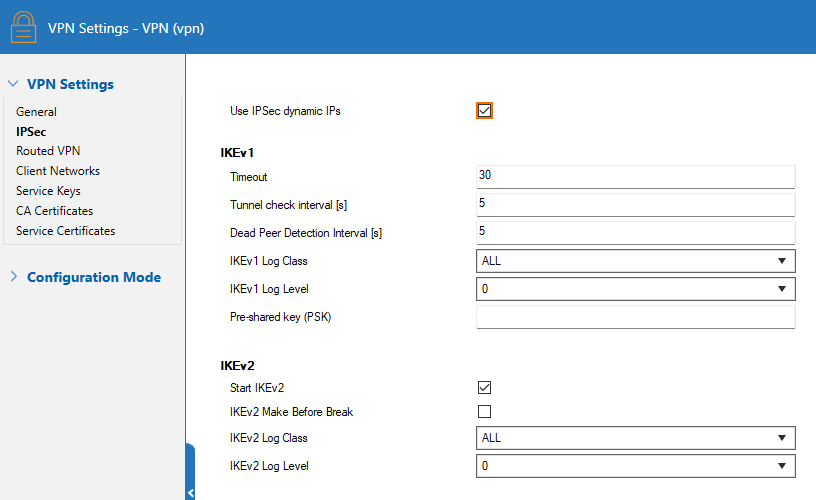
- Click Send Changes and Activate.
Create a VPN Tunnel
Create a VPN IPsec tunnel. For IKEv1: On the local firewall, in the Local Networks settings, enter 0.0.0.0 or ::0 as the Local IKE Gateway. For IKEv2: On the local firewall, under the Network Local tab, enter 0.0.0.0 for the Local Gateway.
For more information, see How to Configure a Site-to-Site IPsec IKEv1 VPN Tunnel and How to Configure a Site-to-Site IPsec IKEv2 VPN Tunnel.
Verify the Listening IP Addresses for the VPN Service
Open the CONTROL > Resources page and double-click either on the VPN service process (e.g., S1_ARVPN) for TINA tunnels or on the ike3 process for IPsec tunnels. In the Info Dialog window, check to see if the VPN service is listening on the IP addresses you configured above (e.g., 127.0.0.1 or 0.0.0.0/0).
VPN service
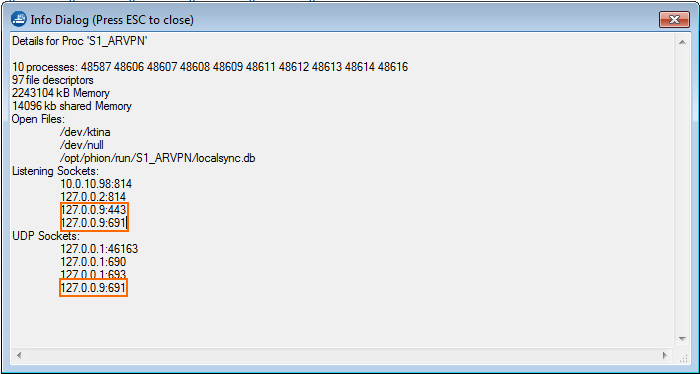
ike3 process with Use dynamic IPs enabled
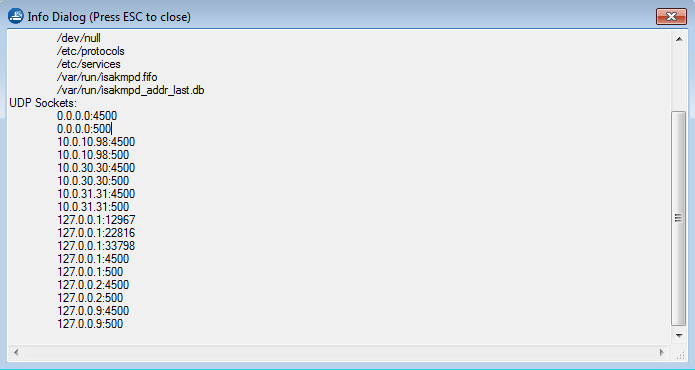
DynDNS
Dynamic WAN connections may change the public IP address regularly. Configure DynDNS to continuously update a DynDNS hostname to always resolve to the current public IP address used by the CloudGen Firewall. VPN clients then use the DynDNS hostname to connect to the CloudGen Firewall VPN service.
